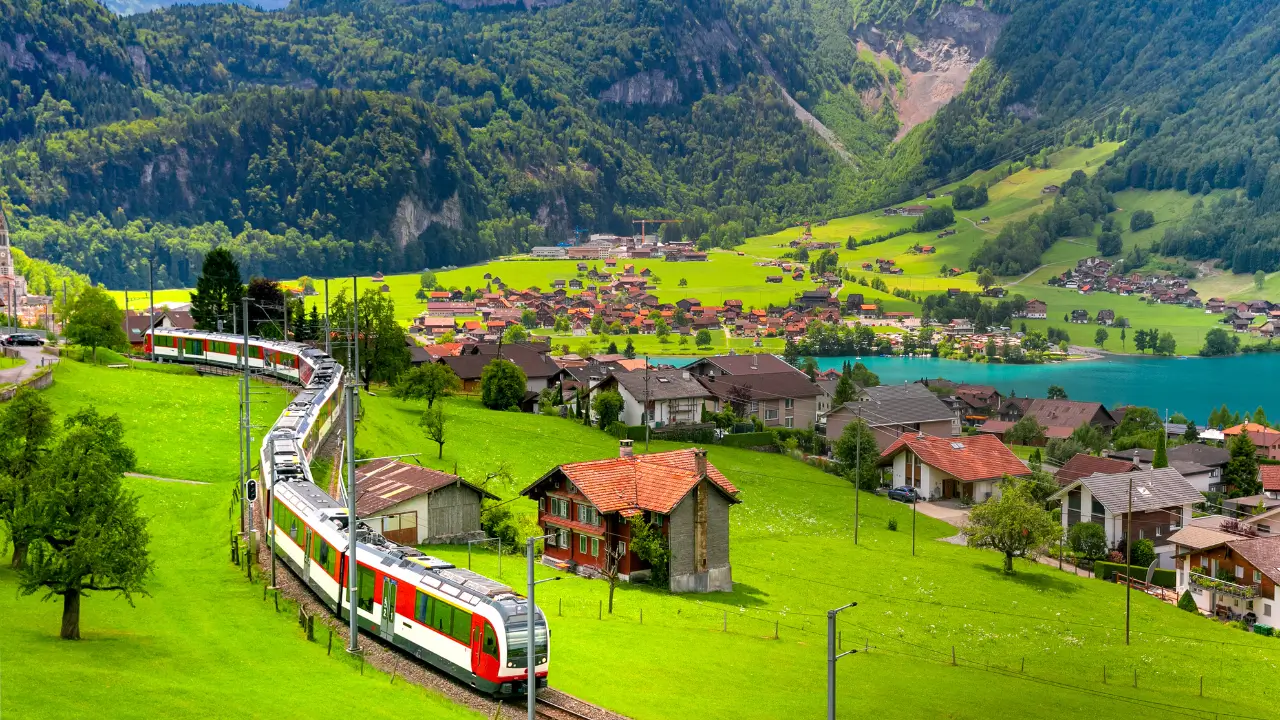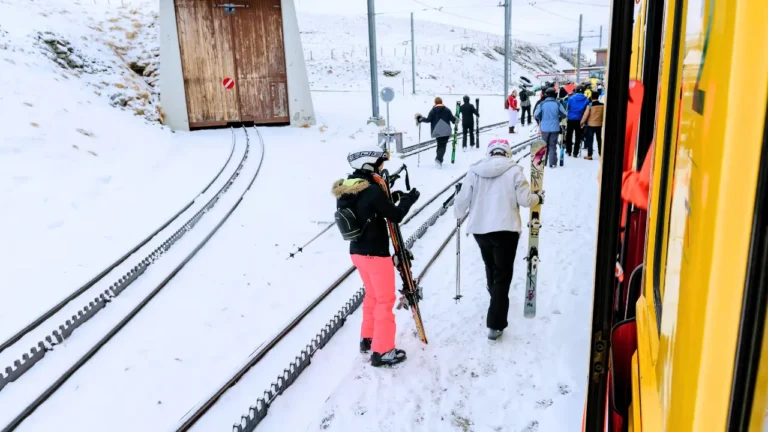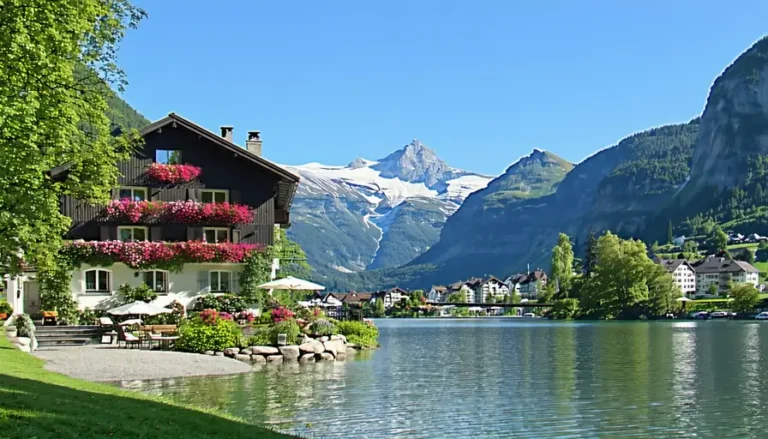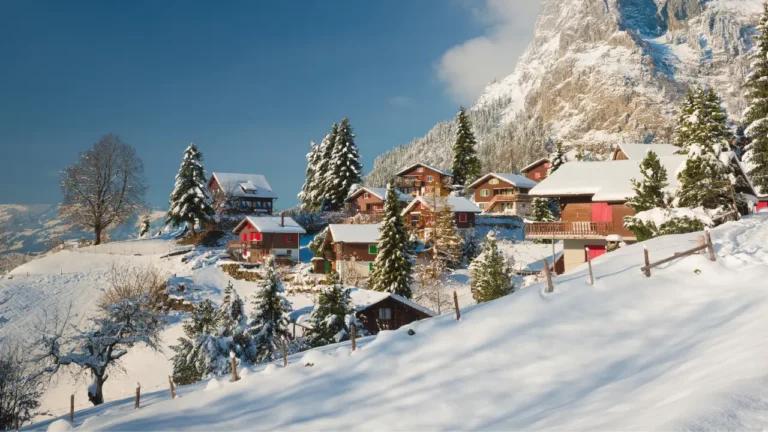What is the cheapest way to travel in Switzerland? It’s the million-franc question every traveler asks before stepping foot in this stunning but pricey alpine paradise. While Switzerland is famous for its efficiency, chocolate, and jaw-dropping scenery, it’s also infamous for its high costs—especially when it comes to transportation.
But here’s the good news: with a little planning and the right strategies, you can explore the best of Switzerland without blowing your budget. This guide is packed with insider tips, local hacks, and smart travel tools that will help you save big on trains, buses, cable cars, and even accommodation.
Whether you’re a student, a solo traveler, or simply someone who loves exploring more for less, this article breaks down what is the cheapest way to travel in Switzerland—step by step. From discount travel passes to free public transport in cities and scenic hiking trails that cost nothing, you’ll discover how to make the most of every Swiss Franc.
Why Traveling in Switzerland is Notoriously Expensive
Cost of Living and Tourism in Switzerland
Switzerland is consistently ranked as one of the top five most expensive countries in the world. Why? Because the cost of living here is sky-high—local wages are high, and so are the prices for goods, services, and especially tourism. A standard meal can cost you upwards of 25 CHF, and a train ticket from Zurich to Geneva might run over 90 CHF if bought last-minute. The country thrives on a luxury tourism model, catering to affluent travelers. Think designer shops, ski resorts, and lakeside chalets.
But don’t be discouraged just yet. That high price tag doesn’t mean budget travel is impossible—it just means you’ll need to travel smarter. Many tourists fall into the trap of not planning in advance, leading to hefty last-minute costs. Add to that the premium pricing of scenic train rides like the Glacier Express and you’ve got a recipe for a budget nightmare—unless you’re equipped with the right tips and tricks.
How Transportation Costs Stack Up
Transportation is where many travelers feel the pinch. The Swiss Federal Railways (SBB) offers excellent, punctual, and efficient train services, but they’re not cheap. A short one-hour train ride could cost the same as a budget airline ticket across Europe. Taxis are even worse, with fares starting at 6 CHF and rising rapidly per kilometer.
Car rentals? They’re convenient but come with high daily rates, fuel costs, and expensive parking fees in most Swiss cities. Domestic flights? Practically non-existent due to the country’s compact geography. So unless you’re ready to splurge, your best bet is learning how to navigate the Swiss transport system on a budget—and yes, that’s totally doable.
Flight prices for a month from New York to Zurich, one way
| Departure at | Stops | Find tickets |
|---|---|---|
| 22 September 2025 | 1 Stop | OW tickets from 222 |
| 23 September 2025 | Direct | OW tickets from 277 |
| 24 September 2025 | Direct | OW tickets from 277 |
| 25 September 2025 | 1 Stop | OW tickets from 332 |
| 16 October 2025 | 2 Stops | OW tickets from 237 |
| 5 October 2025 | Direct | OW tickets from 245 |
| 6 October 2025 | Direct | OW tickets from 245 |
| 7 October 2025 | Direct | OW tickets from 245 |
| 8 October 2025 | Direct | OW tickets from 245 |
| 9 October 2025 | Direct | OW tickets from 245 |
| 10 October 2025 | Direct | OW tickets from 245 |
| 11 October 2025 | Direct | OW tickets from 245 |
| 12 October 2025 | Direct | OW tickets from 245 |
| 13 October 2025 | Direct | OW tickets from 245 |
| 14 October 2025 | Direct | OW tickets from 245 |
| 15 October 2025 | Direct | OW tickets from 245 |
| 4 October 2025 | 1 Stop | OW tickets from 254 |
Budget Transportation Options for Tourists
Swiss Travel Pass – Is It Worth It?
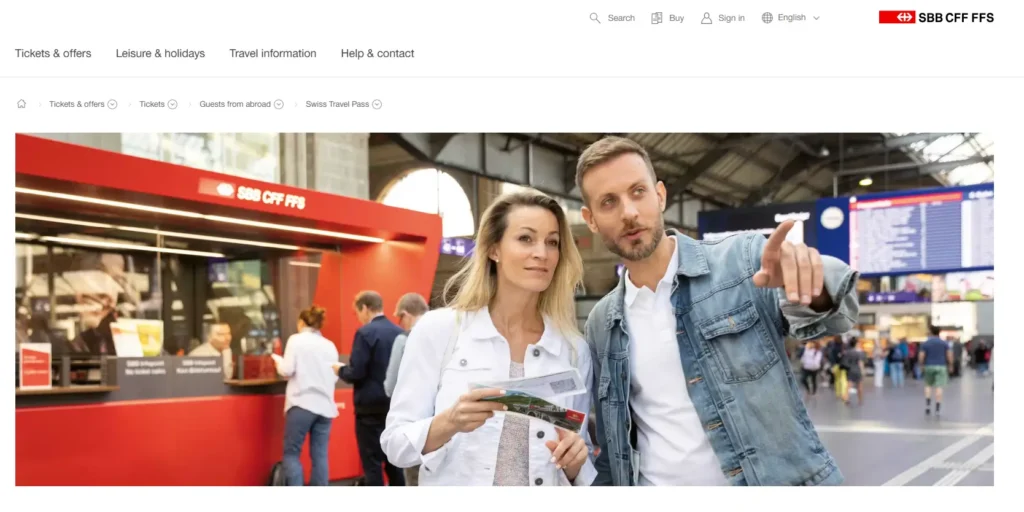
Credit: Swiss Travel Pass
Ah, the Swiss Travel Pass—a traveler’s best friend or a money pit depending on how you use it. This all-in-one ticket gives you unlimited travel on the Swiss public transportation network, including trains, buses, and boats. Plus, you get free admission to over 500 museums and discounts on mountain excursions. Sounds amazing, right? It is—but only if you plan to be super active during your stay.
If you’re hopping from city to city, hitting multiple attractions, and squeezing every drop out of your Swiss itinerary, this pass can be a lifesaver. The cost varies depending on how many days you choose—around 240 CHF for a 3-day pass and up to 485 CHF for 15 days (as of 2025). That’s not cheap, but the value stacks up fast when you factor in individual ticket prices and museum entries.
However, if your trip is slow-paced or limited to one region, you may end up overpaying. Always do the math based on your itinerary. And here’s a tip—buy the pass online in advance for better deals, and keep an eye out for promotional offers especially in the shoulder seasons.
Regional Travel Passes for Cheaper Exploration
If the full Swiss Travel Pass is too much for your plans, consider going regional. Switzerland has a range of regional passes that are way more budget-friendly. For example, the Bernese Oberland Regional Pass or the Tell-Pass (for Central Switzerland) provide similar benefits as the Swiss Travel Pass but are focused on a specific area.
These are perfect for travelers who want to dig deeper into one region rather than darting across the country. Prices are much more manageable—starting around 100 CHF—and still include discounts on mountain trains and cable cars. You also get access to boats and buses in the region, making it super easy to get around without spending a fortune.
And yes, they also come with added perks like museum entries, so don’t overlook these passes when planning your trip.
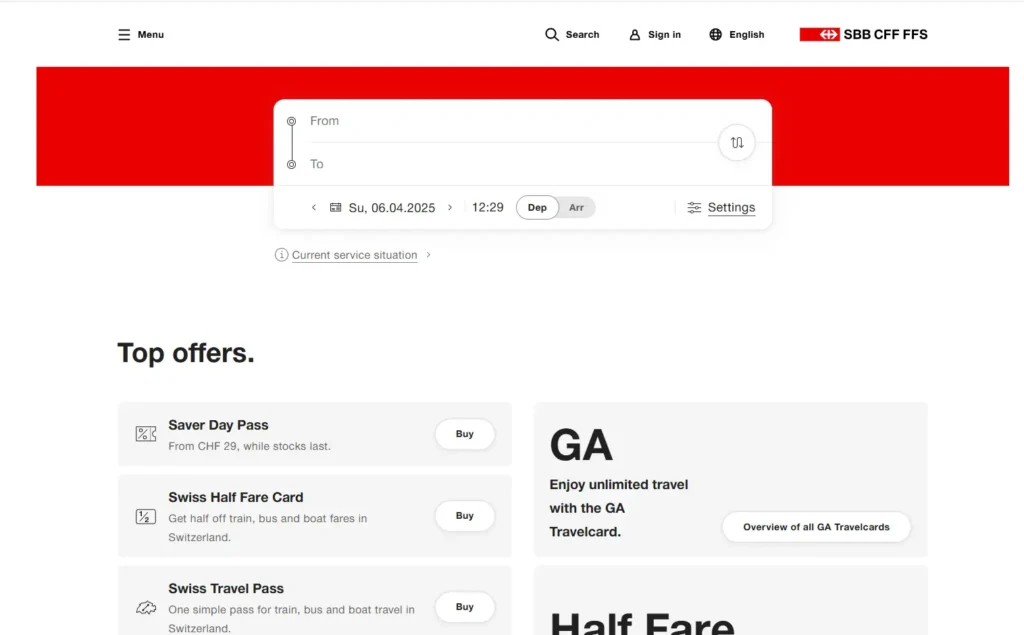
Credit: Swiss Federal Railways
Supersaver Tickets and SBB Deals
Now here’s a real hidden gem for budget travelers—Supersaver Tickets. Offered by SBB (Swiss Federal Railways), these discounted tickets can save you up to 70% off regular train fares. The catch? You need to book them in advance, and they’re non-refundable and tied to a specific train and time.
Still, they’re perfect if you have a fixed itinerary. Just hop on the SBB website or app, select your route and dates, and look for the “Supersaver” option. Combine that with a Swiss Half Fare Card (more on that later), and the savings are mind-blowing.
Also, check out SBB’s “Saver Day Pass” – it lets you travel all day across the Swiss public transport network at a fixed discounted rate if bought in advance. Some lucky travelers manage to snag them for as low as 29 CHF!
Cheap Public Transport Hacks
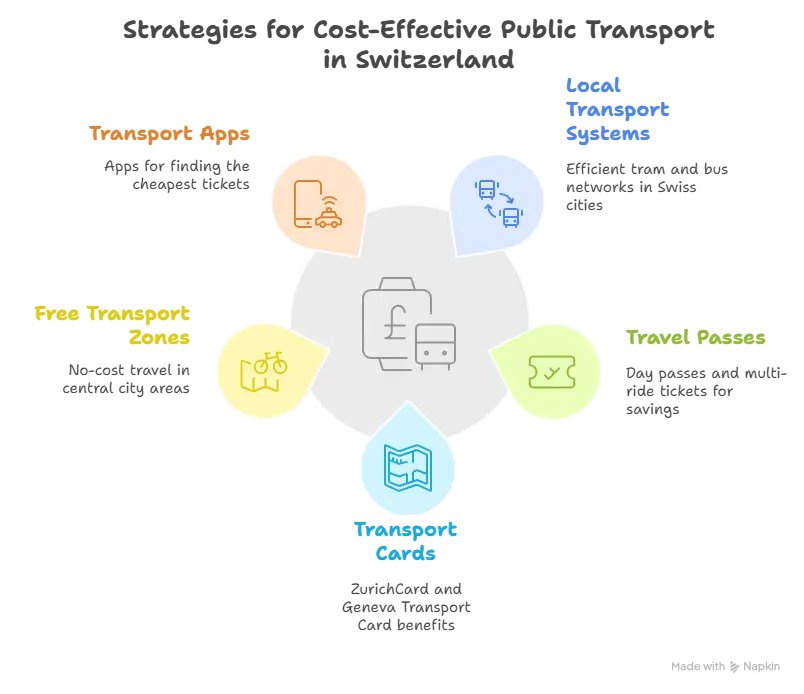
Credit: Napkin ai
Using Local Buses and Trams Effectively
One of the best ways to save money on transportation in Switzerland is by using local public transport. Cities like Zurich, Geneva, Bern, and Basel have incredibly efficient tram and bus systems. You can reach almost every corner of the city through a combination of buses, trams, and commuter trains—all integrated into one seamless network.
Here’s the deal: instead of buying single tickets every time you travel, get a day pass or a multi-ride ticket. A Zurich day pass, for example, costs just a bit more than two single rides but gives you unlimited travel within your selected zones. If you’re staying in the city for a few days, the ZurichCard or Geneva Transport Card (which is often free if you stay in a local hotel) can also save you a lot of cash.
Some cities also offer free transport in the central zone or discounted evening and weekend travel. Check the local city transport authority website or ask your hostel/hotel—they often have up-to-date info on ongoing discounts.
And don’t forget apps! Using apps like SBB Mobile, Fairtiq, or the local transport apps helps you avoid overpaying and lets you buy the cheapest ticket with just a tap.
How to Maximize Free Transport in Cities
Here’s a budget-travel gold nugget: Many Swiss cities offer free public transport for overnight visitors. This means if you’re staying in a registered hotel, hostel, or even some Airbnbs, you might get a free travel card for the duration of your stay. Cities like Lucerne, Geneva, and Basel are known for this generous offer.
The Geneva Transport Card, for example, covers all public transport within the city including buses, trams, trains, and even boats on Lake Geneva. That’s a huge money-saver if you plan to explore city attractions or even hop across the French border.
If you’re staying in smaller towns, ask about local guest cards. These cards often include public transport, entry to local attractions, or discounts for activities. Grindelwald, Interlaken, and Zermatt all have such programs aimed at helping travelers experience more without spending more.
Travel Off-Peak and Save Big
Timing your travels can drastically reduce your expenses. Like most train systems, Swiss transport has peak and off-peak hours. Traveling during rush hours (typically 7–9 AM and 4–6 PM) not only means more crowds but often higher fares unless you’re using a flat-rate pass.
Plan your journeys outside these hours to take advantage of cheaper Supersaver Tickets. Not only will you pay less, but you’ll enjoy quieter trains and better seat availability. Avoiding weekend rush and Swiss school holidays can also make a difference in accommodation and travel costs.
Another tip? Take night trains or early morning departures. They’re often cheaper and help you save on one night’s accommodation if you’re doing long-distance travel.
Hotels in Zurich: Hotels in the center
| Hotel | Stars | Discount | Price before and discount | Select dates |
|---|---|---|---|---|
| Hotel Seehof | ★★★ | -25% | 345 259 | View hotel |
| Hotel Hottingen | ★★ | -22% | 260 204 | View hotel |
| Boutique Hotel Helmhaus Zürich | ★★★★ | -18% | 409 336 | View hotel |
| Sorell Hotel Seefeld | ★★★ | -7% | 398 369 | View hotel |
| Design Hotel Plattenhof | ★★★ | -15% | 285 242 | View hotel |
| Savoy Baur en Ville | ★★★★★ | -12% | 1 321 1 168 | View hotel |
| Hotel Kindli | ★★★ | -7% | 576 538 | View hotel |
| Sorell Hotel Seidenhof | ★★★ | -20% | 492 393 | View hotel |
| B2 Hotel Zürich | ★★★★ | -7% | 547 511 | View hotel |
| easyHotel Zürich City Centre | ★★ | -11% | 144 129 | View hotel |
| Sorell Hotel Rigiblick | ★★★ | -15% | 384 328 | View hotel |
Ride-Sharing and Carpooling in Switzerland
BlaBlaCar and Local Carpool Apps
Switzerland might be known for its punctual trains, but ride-sharing platforms are quietly becoming a go-to budget hack. BlaBlaCar, one of the most popular ride-sharing services in Europe, operates in Switzerland and can be a great way to travel between cities for half the price of a train ticket.
It’s simple—drivers list their planned trips and available seats, and you pay a small fee to ride along. Trips like Zurich to Bern or Lausanne to Lucerne can cost as little as 10-15 CHF depending on the driver and timing. Just make sure to book in advance and read reviews of your driver for a smooth experience.
Besides BlaBlaCar, some Swiss-specific apps and Facebook groups offer informal carpooling opportunities. “Mitfahrgelegenheit” (carpool opportunity) is a term you might come across on bulletin boards in hostels or local cafes.
When Renting a Car Can Be Cheaper
Renting a car in Switzerland usually seems like a pricey option—but if you’re traveling in a group or want to explore remote areas not easily reachable by public transport, it can sometimes be the cheaper alternative.
Here’s the trick: book your rental car in advance and pick it up from a city center rather than the airport to avoid extra fees. Look for rental companies offering unlimited mileage and consider returning the car in the same city to dodge drop-off charges.
Also, avoid toll roads and buy a Swiss motorway vignette (sticker) if you’re planning to use highways. Fuel is expensive, but splitting it among 3–4 people makes it affordable. You’ll also have the freedom to explore less touristy areas, scenic routes, and hidden villages at your own pace. Best car rental for international travelers
Traveling by Bike – A Scenic and Cost-Free Option

Credit: unsplash.com
Best Bike Routes in Switzerland
If you’re up for a bit of physical activity and scenic pleasure, biking across Switzerland can be a dreamy and cost-effective way to travel. With more than 9,000 km of signposted cycling paths, Switzerland is a cyclist’s paradise. Whether you’re coasting along Lake Geneva or climbing toward the Alpine peaks, there’s a bike route for everyone.
The Swiss National Cycle Network offers multiple long-distance trails like Route 1 (Rhine Route), Route 9 (Lakes Route), and Route 4 (Alpine Panorama). These are well-maintained, safe, and provide incredible views.
Many towns and villages are cyclist-friendly and offer parking, rest areas, and information boards. The best part? You save completely on transport and still see some of the most beautiful sights in the country.
Bike Rental Services and Free Bike Options
Don’t have a bike? No worries. Most Swiss cities have bike rental programs—some of them even offer bikes for free! Zurich, Bern, and Geneva allow travelers to borrow bikes for a few hours or even a full day with just a refundable deposit.
Look for services like Publibike, Rent a Bike, or local tourism boards that often collaborate with eco-friendly travel initiatives. Prices vary, but basic bikes start from as low as 10 CHF per day. E-bikes cost a bit more, but they’re fantastic for covering longer distances without breaking a sweat.
Planning a multi-day biking adventure? Some rental services let you rent in one city and return in another, making them ideal for a point-to-point cycling route. Pack light, bring a picnic, and let the Swiss countryside be your scenic highway.
Budget-Friendly Accommodation Near Transport Hubs

Credit: unsplash.com
Hostels and Budget Hotels Close to Stations
Let’s be real—accommodation in Switzerland can eat up a massive chunk of your travel budget if you’re not careful. But the good news? There are plenty of hostels and budget hotels located right near major train stations and bus terminals that can save you both money and time.
Take Zurich and Geneva for example—both cities have well-rated hostels within walking distance from the central station. Places like “Zurich Youth Hostel” or “Geneva Hostel” offer clean dorm beds, free breakfast, and free public transport passes with your stay. These kinds of perks can make a huge difference in your overall expenses.
Even budget hotel chains like ibis or easyHotel often have branches located conveniently near transit points. You’ll pay a bit more than for a hostel, but it’s still cheaper than full-service hotels, especially if you’re splitting the cost with a friend or partner. Always look for properties with kitchen access so you can prepare your own meals—another great way to stretch your budget.
And one more thing: Booking early is everything in Switzerland. The best cheap places sell out months in advance, especially in high season.
Couchsurfing and Home Swaps
Now, if you’re looking to really slash your accommodation costs to zero, then Couchsurfing could be your new best friend. It’s not just free—it’s also a unique way to meet locals, share cultures, and get insider tips on exploring Switzerland on the cheap.
Thousands of Swiss hosts are listed on the Couchsurfing platform, many of whom live in popular cities like Lausanne, Basel, and Lucerne. Staying with a local can also help you skip tourist traps and find budget-friendly, authentic experiences.
Home exchange platforms are also on the rise. If you own or rent a place back home, swapping homes with a Swiss local for a week or two might give you free accommodation in one of the world’s most expensive countries. Sites like HomeExchange.com offer trusted platforms to do just that—just make sure to plan well in advance and communicate clearly with your host.
Hotels in Zurich: Top hotels
| Hotel | Stars | Discount | Price before and discount | Select dates |
|---|---|---|---|---|
| B2 Hotel Zürich | ★★★★ | -7% | 547 511 | View hotel |
| Courtyard by Marriott Zurich North | ★★★★ | -8% | 243 223 | View hotel |
| Boutique Hotel Helmhaus Zürich | ★★★★ | -18% | 409 336 | View hotel |
| Savoy Baur en Ville | ★★★★★ | -12% | 1 321 1 168 | View hotel |
Use of Swiss Half Fare Card to Cut Costs
How It Works and Where to Buy
If the Swiss Travel Pass is too steep for your budget, the Swiss Half Fare Card is your next best friend. Costing just 120 CHF for one month, this card allows you to purchase all train, bus, and boat tickets—and even most mountain transport—at half price. It’s perfect for slow travelers or those with a loose itinerary who still want to save.
You can buy it online via the SBB website, at train stations, or even at major airports upon arrival. It’s incredibly easy to use—just show it when purchasing tickets or enter your card number when booking online to get the discounted fare.
It works seamlessly across the entire Swiss Travel System, and yes—it includes scenic trains like the Glacier Express and Bernina Express (though you still need to pay a seat reservation fee). If your trip is longer than 3-4 days and involves multiple train journeys, the Half Fare Card pays for itself pretty quickly.
When It’s More Cost-Effective Than the Swiss Travel Pass
Let’s break it down with a quick comparison. Say you’re staying in Switzerland for a week and plan on doing 3–4 long-distance trips, a couple of local commutes, and maybe a cable car ride or two. Buying individual tickets at half price using the Half Fare Card could total around 150–200 CHF (plus the 120 CHF card), while the 8-day Swiss Travel Pass would cost around 400 CHF. See the difference?
The Half Fare Card is also stackable with Supersaver and Saver Day Passes, allowing you to layer your discounts for maximum savings. For those not packing every day with back-to-back travel, this card offers flexibility without forcing you to overpay for unused travel days.
Smart Itinerary Planning to Avoid Backtracking
Building a Logical Route to Minimize Expenses
One major mistake many travelers make? Crisscrossing the country with no sense of direction. In Switzerland, backtracking costs time and money—especially if you’re paying for individual train or bus tickets.
Instead, plan a smart loop. Start in one major hub—like Zurich—then move in a logical path through Lucerne, Interlaken, Bern, and Geneva, before looping back. You’ll not only reduce ticket costs but also make better use of travel passes or regional deals.
Consider using regional passes to focus your travel in one area for a few days. For example, base yourself in Interlaken and explore Lauterbrunnen, Grindelwald, and Thun using the Bernese Oberland Pass. Then move to Lucerne and do the same with a Tell-Pass.
Also, group expensive mountain excursions (like Jungfraujoch or Gornergrat) into one or two days when you already have a day pass or special deal, so you get the most out of your spend.
Using Online Tools to Plan Efficient Routes
Switzerland has a super user-friendly travel ecosystem, and that includes online tools that help you map your journey without hiccups. The SBB app is king here—showing schedules, ticket prices, Supersaver options, and platform details all in one place.
Other great apps include Rome2Rio (for multimodal travel suggestions), Omio (for comparing prices between trains, buses, and flights), and Google Maps (which integrates most Swiss public transport timetables).
By plotting out your routes and checking travel durations and transfer times in advance, you avoid missing connections or booking unnecessary detours. And hey, nothing ruins a travel budget faster than a missed train or last-minute ticket!
Exploring Switzerland on Foot
Best Walking Tours and Hiking Routes
Walking might just be the cheapest way to travel—and in Switzerland, it’s also the most breathtaking. Whether you’re wandering through cobblestone streets in Bern’s Old Town or hiking alpine trails in the Bernese Oberland, Switzerland offers countless walking opportunities that cost you absolutely nothing.
Cities like Zurich, Lucerne, and Geneva have self-guided walking tours you can follow using free maps or apps. These will guide you through historic landmarks, scenic lakefronts, and charming neighborhoods. You’ll save on transport and immerse yourself deeper in Swiss culture.
Now, let’s talk hiking—Switzerland is world-famous for its trails. From short walks to multi-day treks, the country has over 65,000 km of marked hiking paths. Popular hikes like the Five Lakes Walk near Zermatt or the Hardergrat Ridge Trail near Interlaken are free, incredibly scenic, and well-maintained.
Just make sure to wear proper shoes, pack snacks, carry water, and check the weather. And don’t be surprised to find mountain huts along the trails offering affordable local food, drinks, and even accommodation for hikers.
Tips for Long Walks Between Towns
If you’re truly on a shoestring budget, consider walking short distances between towns or regions, especially in flatter areas. For example, the walk from Lauterbrunnen to Stechelberg (about an hour) offers stunning views and saves on a short train or bus ride. Similarly, the lakeside trails from Montreux to Chillon Castle or from Spiez to Faulensee are scenic and easy-going.
Carry a lightweight backpack with essentials, use offline maps like Maps.me, and keep a power bank handy for your phone. Also, always have some Swiss Francs or a payment card in case you pass by a small farm stand or local vendor—you’d be amazed at the local cheese and fresh fruit you can pick up along the way.
Walking long distances isn’t just budget-friendly—it’s peaceful, empowering, and gives you a deeper connection with the land and its people.
Final Thoughts: What is the Cheapest Way to Travel in Switzerland Overall?
Traveling in Switzerland doesn’t have to mean draining your wallet. In fact, with the right mix of strategies—smart passes, regional discounts, walking, biking, couchsurfing, and careful planning—you can soak in the Swiss Alps, glide across crystal-clear lakes, and enjoy hearty meals without going broke.
Here’s the ultimate trick: there’s no one-size-fits-all “cheapest” way. Your ideal combo depends on how long you’re staying, where you’re going, and what kind of experience you want. The key is balance.
Use the Swiss Half Fare Card if you’re on a mid-length trip. Combine it with Supersaver Tickets and Saver Day Passes. Take buses for short hauls, trains for scenic long routes, and walk or bike around cities and villages. Stay in hostels or couchsurf. Cook your meals occasionally. And always, always plan ahead.
Switzerland rewards those who research, budget, and travel with intention. With a little prep, you can turn one of the world’s most expensive destinations into an affordable adventure of a lifetime.
FAQs
1. What is the absolute cheapest way to get around Switzerland?
Walking and biking top the list. For longer distances, pairing the Swiss Half Fare Card with Supersaver Tickets often results in the lowest cost.
2. Is it cheaper to buy train tickets in advance in Switzerland?
Yes! Supersaver Tickets and Saver Day Passes are much cheaper when bought early. They are limited in number and prices increase closer to the travel date.
3. Can I use my Eurail Pass in Switzerland?
Yes, Eurail and Interrail passes are valid on most Swiss trains, but you’ll still need to pay reservation fees for panoramic trains like the Glacier Express.
4. How do I find free or very cheap accommodation?
Use Couchsurfing, book hostels early, or look for local guest cards that come with accommodation and free transport perks.
5. What’s the best app for budget travel in Switzerland?
The SBB Mobile app is essential for checking routes, buying discounted tickets, and tracking train schedules. Fairtiq is another great app for automatic low-cost fare tracking.

